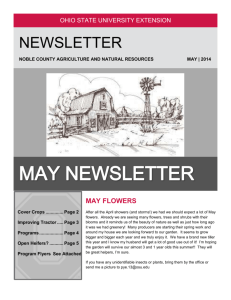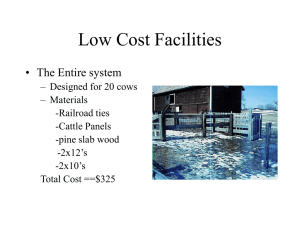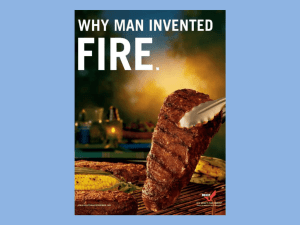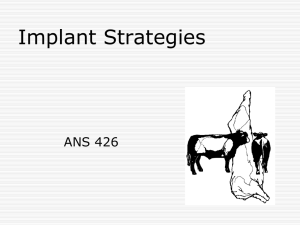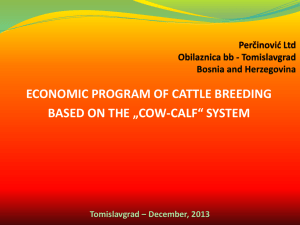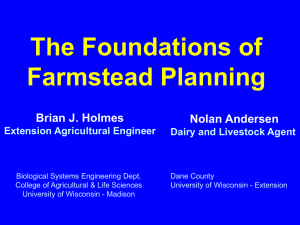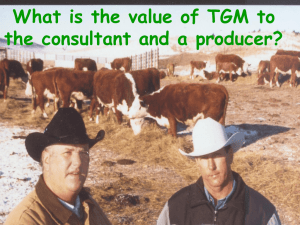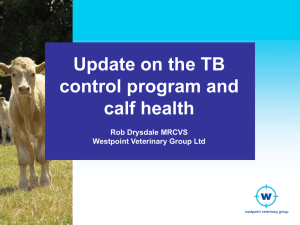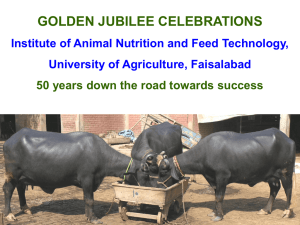Hickson Heifer Mating
advertisement
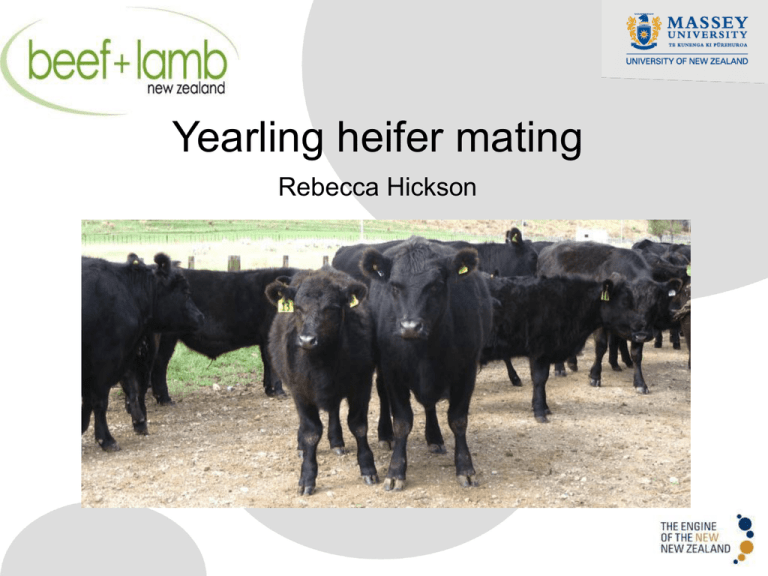
Yearling heifer mating Rebecca Hickson Outline • • • • • • Profitability of calving heifers Beef cow efficiency Why calve heifers Why not calve heifers Performance of heifers in industry How to calve heifers The costs and the income • The 2-year-olds will be there anyway – How much extra has it cost you to feed them to support pregnancy and lactation? • More calves = more income from the beef herd – What is an extra calf worth? Example of extra costs – Assume heifers are 346 kg at 15 months (joining), 484 kg at 31 months (weaning) – Calves are 34 kg at birth, 232 kg at weaning at 208 days of age; 6 kg milk/day – Pasture is 11 MJ ME per kg DM • Non pregnant heifer eats 2565 kg DM • Heifer and calf eat 3713 kg DM • An extra 1149 kg DM (45%) over empty heifer • At 12c/kg DM this is an extra $138 in feed eaten Example of extra income 232 kg weaner at $2.20/kg = $510?? Efficiency (or lack of it) • Beef cows are exceptionally inefficient – 70% of feed requirements are for maintenance • Efficiency depends on – Number of calves weaned – Weight of calves weaned – Feed requirements (live weight) of cows Increasing efficiency • Smaller cows – breed and EBVs • Bigger calves – breed and EBVs, ‘milky’ cows • More calves – National calving percentage hardly changed in 20 years – Getting calves from the 2-year-old heifers increases number of calves far more than any tweaking of calving percentage of mature cows Why calve 2-year-olds? Survey of 331 farmers in charge of 16,000 heifers Reason Important or very important Increased profit 80% Shorter unproductive period of heifers 78% More calves per cow over her lifetime 66% Increased rate of genetic gain 50% Earlier selection of replacements 40% Reduces mature size (maintenance) of heifers 28% Why NOT calve heifers? Reason Important or very important Concerned about rebreeding of 2yo heifers 60% Need mob (empty R2 heifers) that can be fed less when required 51% Stunting of heifers mature size 49% High dystocia in 2yo heifers 37% Requires different management skills 37% Want a higher pregnancy rate than could be achieved at 15 months 37% Returns do not justify the extra costs 23% Simulated profitability and dystocia • Based on a simulated farm with a fixed feed supply, and assuming an assisted birth killed 36% of calves and 11% of heifers… • More profitable to calve 2yo heifers than 3yo heifers as long as incidence of assistance remained below 89% Industry performance of 2yo heifers • 86% pregnant per heifer joined • 78% calves marked per heifer joined • 9.6% heifers assisted at calving – Of 386 assisted births: • 36% of calves died • 11% of heifers died • 84% of heifers that calved at 2 calved again at 3 – 7% were empty, 9% culled for other reasons or died Get heifers ready for joining • Well grown – Reach puberty (mean live weight 297 kg for Angus heifers) – Get a ‘head start’ on the calf – reduce dystocia Choosing the right bulls • All about the EBVs! – Direct calving ease (higher is better) – Birth weight – Accuracy: is birth weight measured in the herd you are buying from? Do they calve their 2 year olds? • Shape is of little (no?) importance, just birth weight • Daughters’ calving ease EBV useful if choosing a bull to father your replacements Feeding during pregnancy • Feeding in early pregnancy does not affect dystocia – Losing 560 g/d from 6-12w of gestation reduced milk production • Feeding in late pregnancy does not affect dystocia reliably – Underfeeding can reduce milk yield, calf weight and pregnancy rate to rebreeding • Keep them within the range of ‘normal’, neither very thin or very fat Management at calving • Where do you calve them? • How often do you observe them? • At what point do you assist? Rebreeding & culling • Cull heifers that don’t get pregnant at 15 months • Dystocia at first calving does not imply future dystocia • Rebreeding at 2 not a big problem (?) Line Angus Angus x Friesian Angus x Jersey Post-partum anoestrus interval (days) 101 Pregnancy rate to second joining 91% 97 90 96% 100% Try it! But choose your bull wisely Thanks to Beef + Lamb NZ for funding the research underpinning this talk

